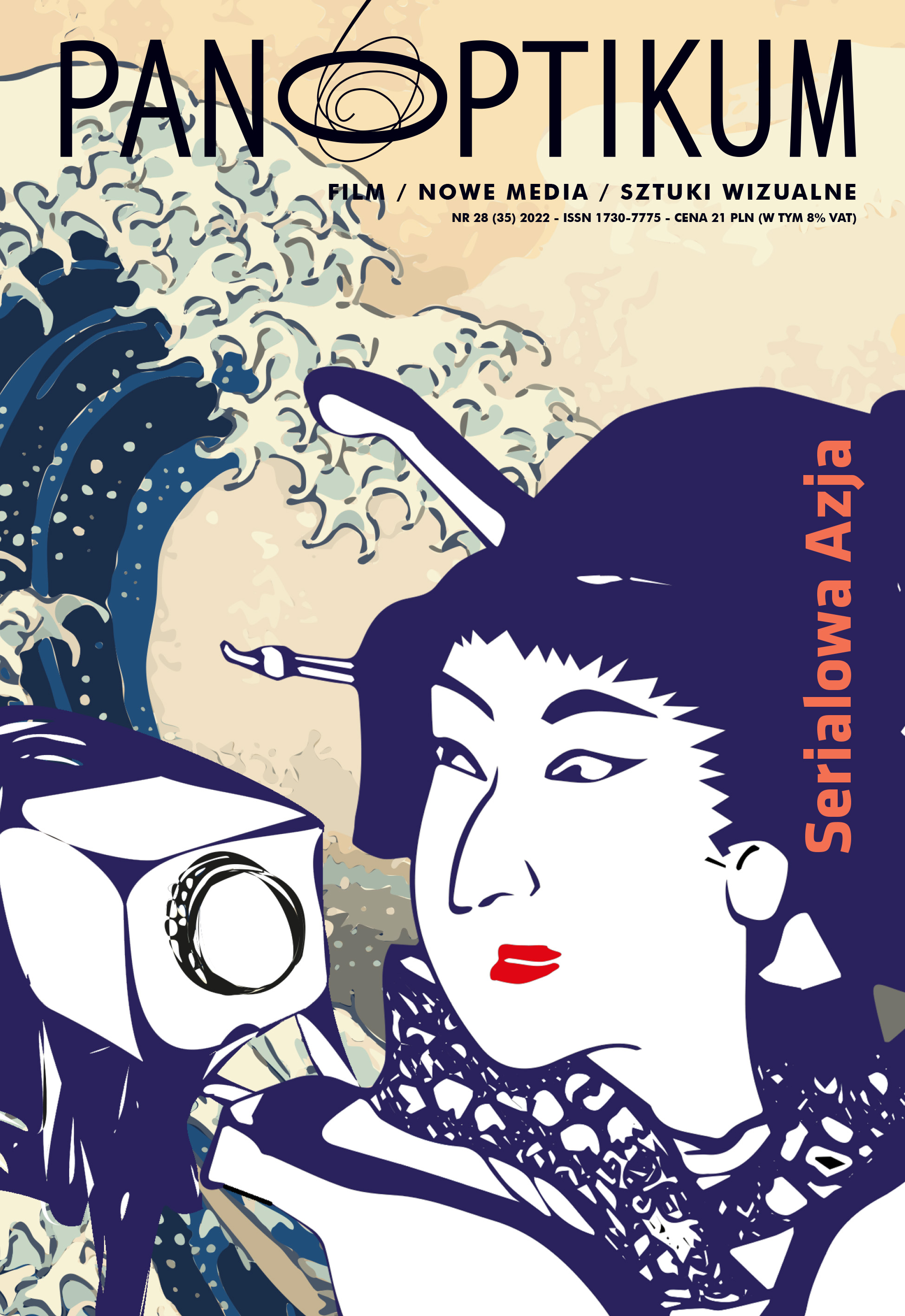Anime studies: Wprowadzenie
DOI:
https://doi.org/10.26881/pan.2022.28.07Downloads
Bibliografia
Anno, H. (1997). Anno Hideaki parano Evangerion (red. Kentarō Takekuma). Tokyo: Ohta shuppan.
Anno, H. (2019). “EVA” no na o akuyō shita GAINAX to hōdō ni tsuyoku ikidōru riyū. https://diamond.jp/articles/-/224881 (dostęp: 30.12.2019).
Azuma, H. (2009) [20011]. Otaku: Japan’s Database Animals. Minneapolis: University of Minnesota Press. (Wprowadzenie i tłumaczenie: Jonathan E. Abel i Shion Kono).
Berndt, J. (2018). Anime in Academia: Representative Object, Media Form, and Japanese Studies. „Arts”, vol. 7, no. 4, s. 56. DOI: https:// doi.org/10.3390/arts7040056.
Bolton, Ch. (2002). From Wooden Cyborgs to Celluloid Souls: Mechanical Bodies in Anime and Japanese Puppet Theater. „positions”, vol. 10, no. 3, s. 729–771.
Bolton, Ch. (2018). Interpreting Anime. Minneapolis: University of Minnesota Press.
Brousseau, J. (2020). “SO MANY FEELS~!” Queering Male Shonen Characters in BL Anime Music. „Synoptique”, vol. 9, no. 1, s. 95–107.
Carroll, N. (1985). The Specificity of Media in the Arts. „The Journal of Aesthetic Education”, vol. 19, no. 4, s. 5–20.
Clements, J. (2013). Anime: A History. London: Bloomsbury.
Crafton, D. (2013). Shadow of a Mouse: Performance, Belief and World-Making in Animation. Berkeley: University of California Press.
Denison, R. (2018). Anime’s Distribution Worlds: Formal and Information Distribution in the Analogue and Digital Eras, [w:] F. Darling-Wolf (red.), Routledge Handbook of Japanese Media (s. 578–601). New York: Routledge.
Denison, R. (2020). Transmedial Relations – Manga at the Movies: Adaptation and Intertextuality, [w:] H. Fujiki, A. Phillips (red.), The Japanese Cinema Book (s. 203–213). London: Bloomsbury.
Du, D.Y. (2019). Animated Encounters: Transnational Movements of Chinese Animation, 1940s–1970s. Honolulu: University of Hawai‘i Press.
Fujiki, H., Phillips A., red. (2020). The Japanese Cinema Book. London: Bloomsbury.
Greenberg, C. (1940). Towards a New Laocoön. „Partisan Review”, July–August, s. 296–310.
Greenberg, R. (2018). Hayao Miyazaki: Exploring the Early Work of Japan’s Greatest Animator. London: Bloomsbury Academic.
Igarashi, T., red. (1997). Evangerion kairaku gensoku. Tokyo: Daisan Shokan.
Kimura, T. (2020). Tōei Dōga shiron: Keiei to sōzō no teiryū. Tokyo; Nihon hyōronsha.
Lamarre, T., red. (2002). Numer specjalny Between Cinema and Anime. „Japan Forum”, vol. 14, no. 2, s. 183–370.
Lamarre, T. (2009). The Anime Machine: A Media Theory of Animation. Minneapolis: University of Minnesota Press.
Lamarre, T. (2018). The Anime Ecology: A Genealogy of Television, Animation, and Game Media. Minneapolis: University of Minnesota Press.
Lamarre, T. (2020). Anime. Compositing and Switching: An Intermedial History of Japanese anime, [w:] H. Fujiki, A. Phillips, red. The Japanese Cinema Book (s. 310–324). London: Bloomsbury.
Litten, F.S. (2017). Animated Film in Japan until 1919: Western Animation and the Beginnings of Anime. Norderstedt: BoD.
Mitchell, W.J.T., Hansen M.B.N., red. (2010). Critical Terms for Media Studies. Chicago–London: University of Chicago Press.
Morishita, T. (2018). Shōgyō to geijutsu no aida ni aru kojin seisaku animēshon no ba ni tsuite no kōsatsu: „Animēshon sannin no kai” o tegakari ni. „Nagoya geijutsu daigaku kenkyū kiyō”, vol. 39, s. 287–303. http://www.nua.ac.jp/kiyou/kiyou2018_2.php?file=/0002%8C%A4%8B%86%8BI%97v%91%E639%8A%AA%81i %98_%95%B6%81j/0019%90X%89%BA%96L%94%FC.pdf &name=%90X%89%BA%96L%94%FC.pdf.
Napier, S. (2001). ANIME from Akira to Princess Mononoke. New York: Palgrave.
Nishimura, T. (2018). Nihon no animēshon wa ikani shite seiritsu shita no ka. Tokyo: Shinwasha.
Novielli, M.R. (2018). Floating Worlds: A Short History of Japanese Animation. Boca Raton, FL: Taylor & Francis.
Pellitteri, M., Wong H., red. (2021). Japanese Animation in Asia: Transnational Industry, Audiences, and Success. London: Routledge.
Proust-Delaspre, M. (2021). Aux Sources de l’Animation Japonaise: Le Studio Tōei Dōga (1956–1972). Rennes: Presses Universitaires de Rennes.
Rendell, J., Denison, R. (2018). Redakcja Wydania Specjalnego: Introducing Studio Ghibli. „East Asian Journal of Popular Culture”, vol. 4, no. 1), s. 5–14.
Roquet, P. (2020). Solo Animation in Japan: Empathy for the Drawn Body, [w:] J. Bernardi, O. Shota (red.), Routledge Handbook of Japanese Cinema (s. 141–152). New York: Routledge.
Sano, A. (2011). „Animēshon” no meishō no hen’yō to „geijutsusei” nitsuite. „Bijutsu Forum” vol. 21, no. 24, s. 73–78.
Sano, A. (2019). Momotarō: Umi no shinpei-ron: Kokusaku animēshon no eizō jikken. „The Japanese Journal of Animation Studies”, vol. 20, no. 1, s. 17–29.
Sano, A., Hori, H., red. (2022). Sensō to Nihon anime – „Momotarō: umi no shinpei” to wa nandatta no ka? Tokyo: Seikyūsha.
Smith, A.N. (2018). Storytelling Industries: Narrative Production in the 21st Century. Cham, Switzerland: Palgrave Macmillan.
Steinberg, M. (2012). Anime’s Media Mix: Franchising Toys and Characters in Japan. Minneapolis, MN: University of Minnesota Press.
Suan, S. (2021). Anime’s Identity: Performativity and Form beyond Japan. Minneapolis: University of Minnesota Press.
Suvilay, B. (wrzesień 2017). Neon Genesis Evangelion ou la déconstruction du robot anime. „ReS Futurae: Revue d’études sur la science-fiction”, http://resf.revues.org/954.
Swale, A.D. (2015). Anime Aesthetics: Japanese Animation and the ‘Post-Cinematic’ Imagination. New York: Palgrave Macmillian.
Wada-Marciano, M. (2010). Global and Local Materialities of Anime, [w:] M. Yoshimoto i in. (red.), Television, Japan, and Globalization (s. 241–258). Ann Arbor, MI: Center for Japanese Studies.
Wilde, L. (2018). Character Street Signs (hyōshiki): „Mangaesque” Aesthetics as Intermedial Reference and Virtual Mediation. „Orientaliska Studier”, vol. 156, s. 130–150. https://oriental iskastudier.se › uploads › 2019/01 › Lukas-R.A.-Wilde.pdf.
Zahlten, A. (2019). „Doraemon” and „Your Name” in China: The Complicated Business of Mediatized Memory in East Asia. „Screen”, vol. 60, no. 2, s. 311–321.

 Uniwersyteckie Czasopisma Naukowe
Uniwersyteckie Czasopisma Naukowe









